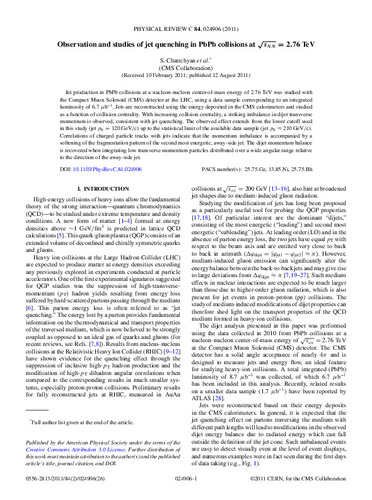Observation and studies of jet quenching in PbPb collisions at √sNN=2.76 TeV
Fecha de publicación:
Versión del editor:
Citación:
Descripción física:
Resumen:
Jet production in PbPb collisions at a nucleon-nucleon center-of-mass energy of 2.76 TeV was studied with the Compact Muon Solenoid (CMS) detector at the LHC, using a data sample corresponding to an integrated luminosity of 6.7 μb−1. Jets are reconstructed using the energy deposited in the CMS calorimeters and studied as a function of collision centrality. With increasing collision centrality, a striking imbalance in dijet transverse momentum is observed, consistent with jet quenching. The observed effect extends from the lower cutoff used in this study (jet pT=120 GeV/c) up to the statistical limit of the available data sample (jet pT≈210 GeV/c). Correlations of charged particle tracks with jets indicate that the momentum imbalance is accompanied by a softening of the fragmentation pattern of the second most energetic, away-side jet. The dijet momentum balance is recovered when integrating low transverse momentum particles distributed over a wide angular range relative to the direction of the away-side jet
Jet production in PbPb collisions at a nucleon-nucleon center-of-mass energy of 2.76 TeV was studied with the Compact Muon Solenoid (CMS) detector at the LHC, using a data sample corresponding to an integrated luminosity of 6.7 μb−1. Jets are reconstructed using the energy deposited in the CMS calorimeters and studied as a function of collision centrality. With increasing collision centrality, a striking imbalance in dijet transverse momentum is observed, consistent with jet quenching. The observed effect extends from the lower cutoff used in this study (jet pT=120 GeV/c) up to the statistical limit of the available data sample (jet pT≈210 GeV/c). Correlations of charged particle tracks with jets indicate that the momentum imbalance is accompanied by a softening of the fragmentation pattern of the second most energetic, away-side jet. The dijet momentum balance is recovered when integrating low transverse momentum particles distributed over a wide angular range relative to the direction of the away-side jet
Identificador local:
20111041
Ficheros en el ítem





